 Image search results - "style" Image search results - "style" |

Sugawara house from Tsuruoka city, Yamagata Prefecture. In heavy snow, the front window was used as the door.
|
|

Ceiling
|
|

Kitamura house brought from Hadano, Kanagawa
|
|

Kitamura house
|
|

Nihon Minkaen is an outdoor museum of traditional farm and merchant houses with thatched roofs. They have 25 homes from around Japan many were donated to the museum for preservation.
|
|
|
|

Thatched roof
|
|

Water nozzles aimed at the house. No smoking.
|
|
|
|
|

Yamada house
|
|
|
|

Emukai house brought from Nanto, Toyama. In the gasshi-zukuri style with steep roof. Kawasaki Nihon Minkaen
|
|

Nihon Minkaen, Kawasaki, Kanagawa
|
|

Inside Emukai house
|
|
|
|
|
|
|
|

Nihon Minkaen, Kawasaki, Kanagawa
|
|

Toilet
|
|

The museum park has 25 homes from around Japan many were donated to the museum for preservation. Near Mukogaoka-yuen Station on the Odakyu Line. Closed Mon. Admission 500 yen.
|
|

Water mill
|
|

Inside water mill
|
|

Hydrangea
|
|

Muikara Minka むいから民家園, former farm house with a thatched-roof house originally built in the late 18th century. Free admission.It got in the way of the Odakyu train line (twice) near Komae Station so it was finally moved here in 2002. Open 9:30 am-4:30 pm (till 6 pm in July-Aug.). Closed Wed. and Thu. Address: Moto-Izumi 2-15-5 狛江市元和泉2-15-5, Phone: 03-3489-8981
|
|

The house was originally located near Senryuji temple's front gate. But it got in the way of the Odakyu Line so it was moved in 1927. Then when the station was expanded in 1992, the house was dismantled and put in storage.
|
|

Finally in 2002, the house was moved to and restored at this location. Dirt-floored kitchen with fire stoves. 土間
|
|

Stoves
|
|

Room with a irori hearth 茶の間
|
|
|
|

Household Shinto altar
|
|
|

Living room with 10 tatami mats. 座敷
|
|
|

Veranda. The home used to be owned by the Arai family.
|
|

Open 9:30 am-4:30 pm (till 6 pm in July-Aug.). Closed Wed. and Thu. Address: Moto-Izumi 2-15-5 狛江市元和泉2-15-5, Phone: 03-3489-8981
|
|

Entrance to Northern Culture Museum, formerly the Japanese-style mansion of the Ito farming family who were a wealthy landowner from the 18th century.
|
|

The museum is within a spacious, garden-like grounds. It includes the main house, tea houses, storehouse, and a few shops and restaurants.
|
|

Monument for Itoh Bunkichi VII (1896-1958) and Lt. Ralph E. Wright (from Peoria, Illinois). Right after WWII in 1945, they saved the property from being demolished due to the Land Reform Act.
|
|

Acting on reports that the Itoh property was storing hidden materials for the old Imperial Army, Lt. Ralph E. Wright from the American Occupation forces conducted a search and met Itoh Bunkichi VII, the owner. Photo: Grave of Ralph E. Wright-Peterson.
|
|

When Wright found out that Bunkichi was a fellow University of Pennsylvania graduate, he fully supported the preservation of the property. They saved the property by converting it into a museum. A foundation was established and the property was donated to it. Pictured is Ralph Wright and Itoh Bunkichi VIII (1927- ), the son of Bunkichi VII (1896-1958).
|
|

It was Japan's first private museum to receive governmental approval. During the years following, it took several years to rebuild the garden and buildings. This is the museum office next to the entrance.
|
|

Entrance foyer (unused). I had the pleasure of meeting Itoh Bunkichi VIII who explained about how the property was saved by Lt. Wright. He was the one who built the monument for his father and Lt. Wright.
|
|

The first room you see is this Cha-no-ma living room where the head of the household greeted guests. Built in 1885-1887, the house has more than 60 rooms, with a floor space of about 4,000 sq. meters. 茶の間
|
|

Cha-no-ma living room
|
|

Corridor facing the courtyard.
|
|

Display of stuffed toki or crested ibis, an endangered species. Official bird of Niigata and raised on Sado island.
|
|

Irori hearth next to the kitchen. 囲炉裏
|
|

Hearth in the kitchen. A bale of rice (60 kg) was cooked every day. Over 50 maids, cooks, and other servants worked in the house.
|
|

2nd floor exhibition room displays various artifacts of the Itoh family. The room formerly served as a storeroom and workroom for making futon and rags. 考古資料館
|
|

Plate
|
|

Courtyard garden as seen from the 2nd floor.
|
|
|

Corridor
|
|

Veranda
|
|

Lacquerware on display
|
|

Room with a view: This is the centerpiece of the former home, a large drawing room (Ohiroma) used for large gatherings. It gives a marvelous view of the garden. 大広間
|
|

Ohiroma drawing room and adjacent garden in autumn.
|
|

Ohiroma drawing room
|
|

Veranda of Ohiroma drawing room
|
|

Ohiroma drawing room was used only a few times a year for wedding and funeral receptions, etc.
|
|

With 100 tatami mats, the Ohiroma drawing room is the most impressive room in the house.
|
|

Courtyard garden 中庭
|
|

Courtyard garden
|
|

Veranda along the courtyard garden
|
|

Corner of rear drawing room (urazashiki)
|
|

Impressive garden views from the rear drawing room (urazashiki)
|
|
|

The rear drawing room was where guests would wait until they were welcomed into the Ohiroma main drawing room.
|
|

Garden facing the drawing rooms. 庭園
|
|

Rear drawing room (Urazashiki) adjacent to the Ohiroma main drawing room.
|
|
|

Built in 1891, Sanraku-tei, a highly unusual triangular tea house. 三楽亭
|
|

Inside Sanraku-tei with unusually shaped tatami mats to fit the triangular floor. It has three rooms, one was a study and another was a tea ceremony room.
|
|
|
|

Museum office
|
|

Inside the Shukokan rice warehouse, now an antique exhibition room. 集古館
|
|
|
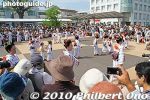
Shimada Mage Matsuri dancers in front of Shimada Station, one of several locations in the city where they danced on Sept. 19, 2010.
|
|
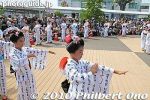
If you go to Kyoto and see geisha, their hairstyle is usually the Shimada-ryu style. One leading theory says that Shimada-ryu originated here in Shimada, Shizuoka Prefecture.
|
|
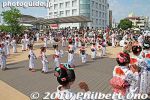
In memory of this haristyle, a group of beauticians and hairdressers in Shimada hold this annual festival where they don the Shimada-ryu hairstyle (usually with their real hair) and dance in yukata.
|
|
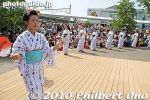
When you see geishain Kyoto, etc., they usually wear a wig. But at this festival, you can see most women using their real hair in the Shimada-ryu style.
|
|
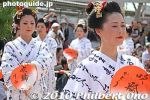
They danced to recorded music.
|
|
|
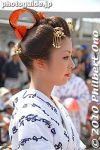
As you can see, there are variations in the hairstyle and adornments of Shimada-ryu.
|
|
|
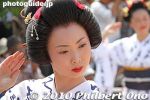
She's wearing a wig.
|
|
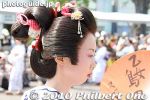
It's pretty easy to tell if it's a wig, with thicker hair strands and bulkier hair. Real hair are pretty thin in comparison. Although Japanese women's hair might've been thicker in the old days.
|
|
|
|
|
|
|
|
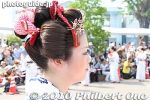
I had never seen so many women wearing Shimada-ryu with their real hair, so I was very impressed.
|
|
|
|
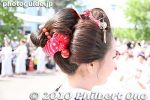
I wonder how much it costs to make your this way in a beauty salon in Shimada. That is, if your hair were long enough.
|
|
|
|
|
|
|
|
|
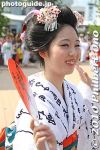
Shimada Mage Matsuri in Shimada, Shizuoka. Her real hair in Shimada-ryu style.
|
|
|
|
|
|
|
|
|
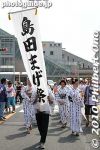
After dancing in front of Shimada Station for about 15 min., the dancers walked to the next location nearby.
|
|
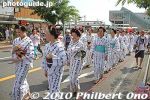
Walking along the main drag in Shimada.
|
|
|
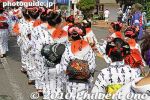
The fans state the name of the hairstyle they are wearing.
|
|
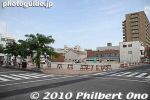
Next dance site. ビック跡地
|
|
|
|
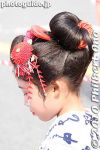
Even little girls don the Shimada-ryu style with their real hair and dance.
|
|
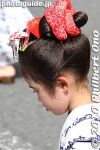
If you have noticed many women and girls with long black hair in Shimada, now you know why.
|
|
|
|
|
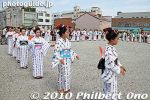
Dancing again.
|
|
|
|
|
|
|
|
|
|
|
|
|
|
|
|
|
|
|
|
|
|
|
|
|
|
|
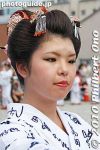
Shimada Mage Matsuri in Shimada, Shizuoka. Her real hair in Shimada-ryu style.
|
|
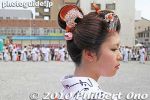
Shimada-ryu hairstyle at Shimada Mage Matsuri, Shizuoka.
|
|
|
|
|
|
|
|
|
|
|
|
|
|
|
|
|
|
|
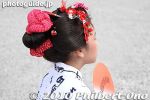
I wonder if 7-year-old girls in Shimada have their hair done in Shimada-ryu for shichi-go-san.
|
|
|
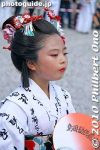
Another hairstyle variation.
|
|
|
|
|
|
|
|
|
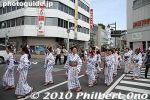
They now proceed to Oi Shrine to dance there. The festival also has a thanksgiving prayer at the shrine in honor of the Shimada-ryu hairstyle. Unfortunately, I had to leave Shimada and could not see it.
|
|
|

Shimada Mage Matsuri video.
|
|
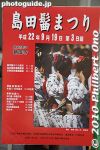
Shimada Mage Matsuri poster for 2010.
|
|
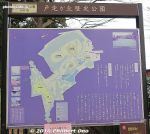
Built in 1884, Tojotei was the residence of Tokugawa Akitake (1853-1910), brother of the last Shogun Tokugawa Yoshinobu. Tojotei is within the garden-like Tojogaoka History Park that was part of Akitake's estate. It now has the Tojo History Museum displaying Akitake artifacts, plum blossoms, cherry blossoms, lots of azalea, and fall foliage. Short walk from Matsudo Station. Park hours are 9 am to 5 pm, closed Mon. (open if a national holiday) Free admission. Small admission charged by Tojotei and the museum.
|
|

Entrance to Tojogaoka History Park.Akitake was supposed to be the next shogun after Yoshinobu, but the Tokugawa reign and Edo Period ended before his time. Akitake only became the last daimyo of the Mito Clan in Ibaraki. He retired at age 30 and lived the rest of his life at Tojotei, a spacious, Japanese-style residence on a hilltop.
|
|

Early-blooming Kawazu-zakura cherry blossoms. I visited in late Feb. 2016.
|
|

Kawazu-zakura cherry blossoms
|
|

Tojotei
|
|

Plum blossoms and Tojotei
|
|

Plum blossoms and Tojotei
|
|

Red plum blossoms
|
|
|

Tojotei. We could enter the residence and step out into the lawn. So when you enter Tojotei, take your shoes with you. Shoe bag provided.
|
|

Built in 1884, Tojotei was the residence of Tokugawa Akitake (1853-1910), brother of the last Shogun Tokugawa Yoshinobu. Matsudo, Chiba, Prefecture
|
|
|
|

View from Tojotei. Tokyo Skytree visible.
|
|

Azalea
|
|

Kura storehouse
|
|

Inside Kura storehouse
|
|

Main room of Tojotei with sweeping views of the lawn outside. Tojotei residence, Matsudo, Chiba.
|
|

They had Hinamatsuri Girls Day dolls decorating the room in late Feb. Tojotei residence, Matsudo, Chiba.
|
|

Hinamatsuri Girls Day dolls
|
|

Hinamatsuri Girls Day dolls
|
|
|

Transom
|
|

Japanese-style rooms inside Tojotei.
|
|
|
|
|
|

Sink for the young couple.
|
|
|
|

Inner courtyard garden
|
|
|

Round window at Tojotei
|
|

Bathroom
|
|

Bathroom in Tojotei
|
|
|
|
|
|

Transom with a butterfly designin Tojotei.
|
|
|

Urinal and toilet
|
|
|
|
|
|
|
|
|